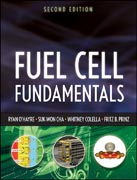
As the search for alternative fuels heats up, no topic is hotter than fuel cells. Filling a glaring gap in the literature, Fuel Cell Fundamentals, Second Edition gives advanced undergraduate and beginning level graduate students an important introduction to the basic science and engineering behind fuel cell technology. Emphasizing the foundational scientific principles that apply to anyfuel cell type or technology, the text provides straightforward descriptions of how fuel cells work, why they offer the potential for high efficiency, and how their unique advantages can best be used. Designed to be accessible to fuel cell beginners, the text is suitable for any engineering or science major with a background in calculus, basic physics, and elementary thermodynamics. This new edition provides updated and enhanced examples, problems, and pedagogy for classroom use and features a significantly enlarged section on the practical applications of fuel cell technology. A solutions manual will be developed. INDICE: PREFACE. ACKNOWLEDGMENTS. NOMENCLATURE. I FUEL CELL PRINCIPLES. 1 INTRODUCTION. 1.1 What is a Fuel Cell? 1.2 A Simple Fuel Cell. 1.3 Fuel Cell Advantages. 1.4 Fuel Cell Disadvantages. 1.5 Fuel Cell Types. 1.6 Basic Fuel Cell Operation. 1.7 Fuel Cell Performance. 1.8 Characterization and Modeling. 1.9 Fuel Cell Technology. 1.10 Fuel Cells and the Environment. Chapter Summary. Chapter Exercises. 2 FUEL CELL THERMODYNAMICS. 2.1 Thermodynamics Review. 2.2 Heat Potential of a Fuel: Enthalpy of Reaction. 2.3 Work Potential of a Fuel: Gibbs Free Energy. 2.4 Predicting Reversible Voltage of a Fuel Cell Under Non-Standard-State Conditions. 2.5 Fuel Cell Efficiency. 2.6 Thermal and Mass Balances in Fuel Cells. Chapter Summary. Chapter Exercises. 3 FUEL CELL REACTION KINETICS. 3.1 Introduction to Electrode Kinetics. 3.2 Why Charge Transfer Reactions Have an Activation Energy. 3.3 Activation Energy Determines Reaction Rate. 3.4 Calculating Net Rate of a Reaction. 3.5 Rate of reaction at Equilibrium:Exchange current Density. 3.6 Potential of a Reaction at Equilibrium: GalvaniPotential. 3.7 Potential and Rate: ButlerVolmer Equation. 3.8 Exchange Currents and Electrocatalysis: How to Improve Kinetic Performance. 3.9 Simplified Activation Kinetics: Tafel Equation. 3.10 Different Fuel Cell Reactions Produce Different Kinetics. 3.11 Catalyst-Electrode Design. 3.12 Quantum Mechanics: Framework for Understanding Catalysis in Fuel Cells. 3.13 Connecting the ButlerVolmer and Nernst Equations (Optional). Chapter Summary. Chapter Exercises. 4 FUEL CELL CHARGE TRANSPORT. 4.1 Charges Move in Response to Forces. 4.2 Charge Transport Results in a Voltage Loss. 4.3 Characteristics of Fuel Cell Charge Transport Resistance. 4.4 Physical Meaning of Conductivity. 4.5 Review of Fuel Cell Electrolyte Classes. 4.6 More on Diffusivity and Conductivity (Optional).4.7 Why Electrical Driving Forces Dominate Charge Transport (Optional). 4.8 Quantum MechanicsBased Simulaton of Ion Conduction in Oxide Electrolytes (Optional). Chapter Summary. Chapter Exercises. 5 FUEL CELL MASS TRANSPORT. 5.1 Transport in Electrode Versus Flow Structure. 5.2 Transport in Electrode: Diffusive Transport. 5.3 Transport in Flow Structures: Convective Transport. Chapter Summary. Chapter Exercises. 6 FUEL CELL MODELING. 6.1 Putting It All Together: A Basic Fuel Cell Model. 6.2 A 1D Fuel Cell Model. 6.3 Fuel Cell Models Based on Computational Fluid Dynamics (Optional). Chapter Summary. Chapter Exercises. 7 FUEL CELL CHARACTERIZATION. 7.1 What Do We Want to Characterize? 7.2 Overview of Characterization Techniques. 7.3 In Situ Electrochemical Characterization Techniques. 7.4 Ex Situ Characterization Techniques. Chapter Summary. Chapter Exercises. II FUEL CELL TECHNOLOGY. 8 OVERVIEW OF FUEL CELL TYPES. 8.1 Introduction. 8.2 Phosphoric Acid Fuel Cell. 8.3 Polymer Electrolyte Membrane FuelCell. 8.4 Alkaline Fuel Cell. 8.5 Molten Carbonate Fuel Cell. 8.6 Solid OxideFuel Cell. 8.7 Other Fuel Cells. 8.8 Summary Comparison. Chapter Summary. Chapter Exercises. 9 PEMFC AND SOFC MATERIALS. 9.1 PEMFC Electrolyte Materials. 9.2 PEMFC Electrode/Catalyst Materials. 9.3 SOFC Electrolyte Materials. 9.4 SOFC Electrode/Catalyst Materials. 9.5 Material Stability, Durability, And Lifetime. Chapter Summary. Chapter Exercises. 10 OVERVIEW OF FUEL CELL SYSTEMS. 10.1Fuel Cell Stack (Fuel Cell Subsystem). 10.2 The Thermal Management Subsystem.10.3 Fuel Delivery/Processing Subsystem. 10.4 Power Electronics Subsystem. 10.5 Case Study of Fuel Cell System Design: Stationary Combined Heat and Power Systems. 10.6 Case Study of Fuel Cell System Design: Sizing A Portable Fuel Cell. Chapter Summary. Chapter Exercises. 11 FUEL PROCESSING SUBSYSTEM DESIGN. 11.1 Fuel Reforming Overview. 11.2 WaterGas Shift Reactors. 11.3 Carbon MonoxideClean-Up. 11.4 Reformer and Processor Efficiency Losses. 11.5 Reactor Design for Fuel Reformers and Processors. Chapter Summary. Chapter Exercises. 12 THERMAL MANAGEMENT SUBSYSTEM DESIGN. 12.1 Overview of Pinch Point Analysis Steps. Chapter Summary. Chapter Exercises. 13 FUEL CELL SYSTEM DESIGN. 13.1 Fuel CellDesign Via Computational Fluid Dynamics. 13.2 Fuel Cell System Design: a CaseStudy. Chapter Summary. Chapter Exercises. 14 ENVIRONMENTAL IMPACT OF FUEL CELLS. 14.1 Life Cycle Assessment. 14.2 Important Emissions For LCA. 14.3 Emissions Related to Global Warming. 14.4 Emissions Related to Air Pollution. 14.5 Analyzing Entire Scenarios with LCA. Chapter Summary. Chapter Exercises. APPENDIXES. A CONSTANTS AND CONVERSIONS. B THERMODYNAMIC DATA. C STANDARD ELECTRODE POTENTIALS AT 25 C. D QUANTUM MECHANICS. D.1 Atomic Orbitals. D.2 Postulates of Quantum Mechanics. D.3 One-Dimensional Electron Gas. D.4 Analogy to Column Buckling. D.5 Hydrogen Atom. E PERIODIC TABLE OF THE ELEMENTS. F SUGGESTED FURTHER READING. G IMPORTANT EQUATIONS. BIBLIOGRAPHY. INDEX.
- ISBN: 978-0-470-25843-9
- Editorial: John Wiley & Sons
- Encuadernacion: Cartoné
- Páginas: 546
- Fecha Publicación: 11/02/2009
- Nº Volúmenes: 1
- Idioma: Inglés
